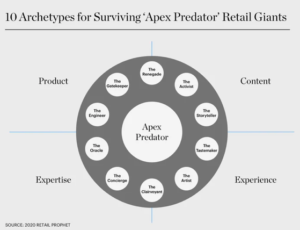Story
When marketing strategy is worthless


Imagine the following scenario: it’s the annual brand strategy seminar for a large, multi-national B2C company. The VP of Marketing goes on stage to present the new marketing model. Everybody is curious because nobody knows what he’s been planning, not even his direct reports.
The new marketing model, it turns out, represents a shift from awareness to a more engagement and loyalty-driven emphasis. All good news. As part of the model, the VP launches a new consumer intimacy strategy focused on customer loyalty and CRM. Going forward it’s all about collecting data and communication with consumers based on expressed interests and needs. The return is higher ROI per customer and generally increased sales.
Everybody turns to look at the digital marketing department who have been pushing for a more consumer-intimacy based marketing approach for years. The digital director looks surprised as he has heard nothing of the VP’s CRM agenda but is excited to hear about his plan for achieving it.
Unfortunately, this plan does not materialise. There is no objective of building CRM competencies in the organization; no intention of re-structuring departments, roles and responsibilities and workflow; no proposal for investing in a supporting IT platform; and no plans to re-allocate budgets.
‘A made-up example’, you’re thinking. Alas, it’s not, it’s a real example from the real world. By now, you’ll will have figured out that this fine CRM strategy wasn’t carried out – until five or six years later when the company launched ecommerce. With a new marketing VP.
The Lack Of Operational Awareness
So, are this company and this marketing VP the only ones who forgot to think about the operational implications of an otherwise appropriate and well-intended strategy? Not at all:
- There are other senior marketing leaders like our VP here who enthusiastically proclaim a new consumer intimacy strategy, without having any plan or budget for developing a CRM platform, competencies, processes; or any insight to the changes such strategy imposes on IT, marketing, sales, customer service, HR, and possibly other functions.
- There are companies who roll out new customer experience initiatives without any processes, systems or operating plans in place to support it, ideas that are great on paper but turn out to be almost impossible to execute and manage within the given corporate structure and culture.
- There are brands that roll out a new digitally-based marketing approach but forget that they have to build the skills required, re-engineer the marketing process, re-allocate the budgets, and negotiate support and buy-in from IT.
- And there are still companies who gladly throw millions of euros/dollars after marketing programs without measuring results and gathering learnings to inform subsequent programs. Or try to develop and execute so-called integrated marketing without an integrated process and shared objectives, leading to silo’ed, dis-integrated results.
All of which 1) creates big problems down the line that take time and effort to resolve, and 2) adds costs on the top and bottom line.
Of course you, esteemed readers, are not among these companies. But you have probably come across similar situations in your career. A business can have the best marketing strategy in the world but if the skills, structure, systems, processes, and relationships are not in place to carry it out, it’s worthless.
The Sexy Stuff
I believe marketing is suffering from a misconception. A misconception that strategy is the sexy part and operations is not. Granted, the strategy part is what gets people excited and what can be laid out in wonderful charts and on large, colourful boards. And in the old marketing world, strategy was pretty much all that mattered because implementation was easy.
Today, managing and achieving effective marketing is a whole other ballgame. Strategy is obviously a main ingredient but it’s not the only one. Marketing has become more operations-heavy with the advent of digital media and a globalized multi-channel landscape – the implications of which are that the operational side of things has become equally important.
Executing a modern marketing strategy requires getting down and dirty with the details. It requires getting into the engine room and understanding the detailed workflow of most parts of the business. It can be tedious and it certainly demands being open and willing to learn new things outside one’s immediate area of expertise or interest. Marketing operations may seem less sexy but it has to be there and it has to be highly efficient. That’s plenty sexy to me!
Growing Focus On Marketing Operations
The good news is that companies and their senior marketing leaders are starting to realize just how big a role operations play in marketing. The strategy has very limited value without the operational set-up to match. Marketing efforts become expensive and frustrating.
They are starting to understand the importance of building and driving a high-efficient marketing organization that is able to manage not only a globalized, multi-channel landscape but also change and ambiguity – and do it in a resource-effective way, employing data, systems, and processes that boost efficiency and bottom line.
Many are beginning to recruit marketing integration directors to ensure marketing campaigns and programs are cohesive, joined-up, and based on common goals. Others are taking a step further by recruiting marketing operations directors to manage and navigate the increasingly fine web of processes, structures, objectives, insights, relationships, and systems required to plan and execute effective marketing today.
These marketing leaders appreciate that marketing operations contribute in a very tangible way to the business, that it needs to managed with as much focus on ROI as the marketing strategy. And that marketing operations in fact is strategic too.
_________________________________________________________________________________________
ARTICLE HIGHLIGHTS
- There are still companies who throw out millions trying to develop and execute so-called integrated marketing without an integrated process and shared objectives, leading to siloed, dis-integrated results.
- Marketing is suffering from the misconception that strategy is sexy and operations is not.
- Strategy has very limited value without the operational set-up to match; marketing efforts become expensive and frustrating. Increasingly, marketing leaders need to focus as much on the operational as the strategy side of things.
_________________________________________________________________________________________
This article is featured at CMO.com.





